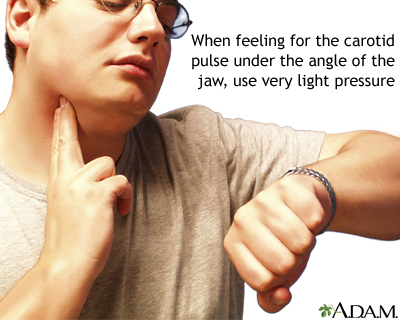Pulse - bounding
Bounding pulseA bounding pulse is a strong throbbing felt over one of the arteries in the body. It is due to a forceful heartbeat.
Causes
A bounding pulse and rapid heart rate may both occur in the following conditions or events:
- Abnormal or rapid heart rhythms
- Anemia
Anemia
Anemia is a condition in which the body does not have enough healthy red blood cells. Red blood cells provide oxygen to body tissues. Different type...
 ImageRead Article Now Book Mark Article
ImageRead Article Now Book Mark Article - Anxiety
- Long-term (chronic) kidney disease
- Fever
- Heart failure
- Heart valve problem called aortic regurgitation
Aortic regurgitation
Aortic regurgitation is a heart valve disease in which the aortic valve does not close tightly. This allows blood to flow from the aorta (the larges...
 ImageRead Article Now Book Mark Article
ImageRead Article Now Book Mark Article - Heavy exercise
- Overactive thyroid (hyperthyroidism)
Hyperthyroidism
Hyperthyroidism is a condition in which the thyroid gland makes too much thyroid hormone. The condition is often called overactive thyroid.
 ImageRead Article Now Book Mark Article
ImageRead Article Now Book Mark Article - Pregnancy, because of increased fluid and blood in the body
- Use of caffeine or other stimulants
When to Contact a Medical Professional
Contact your health care provider if the intensity or rate of your pulse increases suddenly and does not go away. This is very important when:
- You have other symptoms along with increased pulse, such as chest pain, shortness of breath, feeling faint, or loss of consciousness.
- The change in your pulse does not go away when you rest for a few minutes.
- You already have been diagnosed with a heart problem.
The carotid arteries take oxygenated blood from the heart to the brain. The pulse from the carotids may be felt on either side of thefront of the neck just below the angle of the jaw. This rhythmic beat is caused by varying volumes of blood being pushed out of the heart toward the extremities.
What to Expect at Your Office Visit
Your provider will do a physical exam that includes checking your temperature, pulse, rate of breathing, and blood pressure. Your heart and circulation will also be checked.
Your provider will ask questions such as:
- Is this the first time you have felt a bounding pulse?
- Did it develop suddenly or gradually? Is it always present, or does it come and go?
- Does it only happen along with other symptoms, such as palpitations? What other symptoms do you have?
- Does it get better if you rest?
- Are you pregnant?
- Have you had a fever?
- Have you been very anxious or stressed?
- Do you have other heart problems, such as heart valve disease, high blood pressure, or congestive heart failure?
- Do you have kidney disease?
- Do you consume stimulants such as caffeine or cold medicine or drugs such as amphetamines or cocaine?
The following diagnostic tests may be performed:
- Blood studies (CBC or blood count), basic metabolic panel
CBC
A complete blood count (CBC) test measures the following:The number of white blood cells (WBC count)The number of red blood cells (RBC count)The numb...
 ImageRead Article Now Book Mark Article
ImageRead Article Now Book Mark ArticleBlood count
The blood differential test measures the percentage of each type of white blood cell (WBC) that you have in your blood. It also reveals if there are...
 ImageRead Article Now Book Mark Article
ImageRead Article Now Book Mark ArticleBasic metabolic panel
The basic metabolic panel is a group of blood tests that provides information about your body's metabolism.
 ImageRead Article Now Book Mark Article
ImageRead Article Now Book Mark Article - Chest x-ray
Chest x-ray
A chest x-ray is an x-ray of the chest, lungs, heart, large arteries, ribs, and diaphragm.
 ImageRead Article Now Book Mark Article
ImageRead Article Now Book Mark Article - Electrocardiogram (ECG)
Electrocardiogram
An electrocardiogram (ECG) is a test that records the electrical activity of the heart.
 ImageRead Article Now Book Mark Article
ImageRead Article Now Book Mark Article - Echocardiogram
Echocardiogram
An echocardiogram is a test that uses sound waves to create pictures of the heart. The picture and information it produces is more detailed than a s...
 ImageRead Article Now Book Mark Article
ImageRead Article Now Book Mark Article
References
Fang JC, O'Gara PT. History and physical examination: an evidence-based approach. In: Libby P, Bonow RO, Mann DL, Tomaselli GF, Bhatt DL, Solomon SD, eds. Braunwald's Heart Disease: A Textbook of Cardiovascular Medicine. 12th ed. Philadelphia, PA: Elsevier; 2022:chap 13.
Japp AG, Din JN, Robson JMJ. The cardiovascular system. In: Dover AR, Innes JA, Fairhurst K, eds. Macleod's Clinical Examination. 15th ed. Philadelphia, PA: Elsevier; 2024:chap 4.
McGrath JL, Bachmann DJ. Vital signs measurement. In: Roberts JR, Custalow CB, Thomsen TW, eds. Roberts and Hedges' Clinical Procedures in Emergency Medicine and Acute Care. 7th ed. Philadelphia, PA: Elsevier; 2019:chap 1.
The carotid arteries take oxygenated blood from the heart to the brain. The pulse from the carotids may be felt on either side of thefront of the neck just below the angle of the jaw. This rhythmic beat is caused by varying volumes of blood being pushed out of the heart toward the extremities.
Taking your carotid pulse
illustration
The carotid arteries take oxygenated blood from the heart to the brain. The pulse from the carotids may be felt on either side of thefront of the neck just below the angle of the jaw. This rhythmic beat is caused by varying volumes of blood being pushed out of the heart toward the extremities.
Taking your carotid pulse
illustration
Review Date: 4/9/2024
Reviewed By: Frank D. Brodkey, MD, FCCM, Associate Professor, Section of Pulmonary and Critical Care Medicine, University of Wisconsin School of Medicine and Public Health, Madison, WI. Also reviewed by David C. Dugdale, MD, Medical Director, Brenda Conaway, Editorial Director, and the A.D.A.M. Editorial team.




